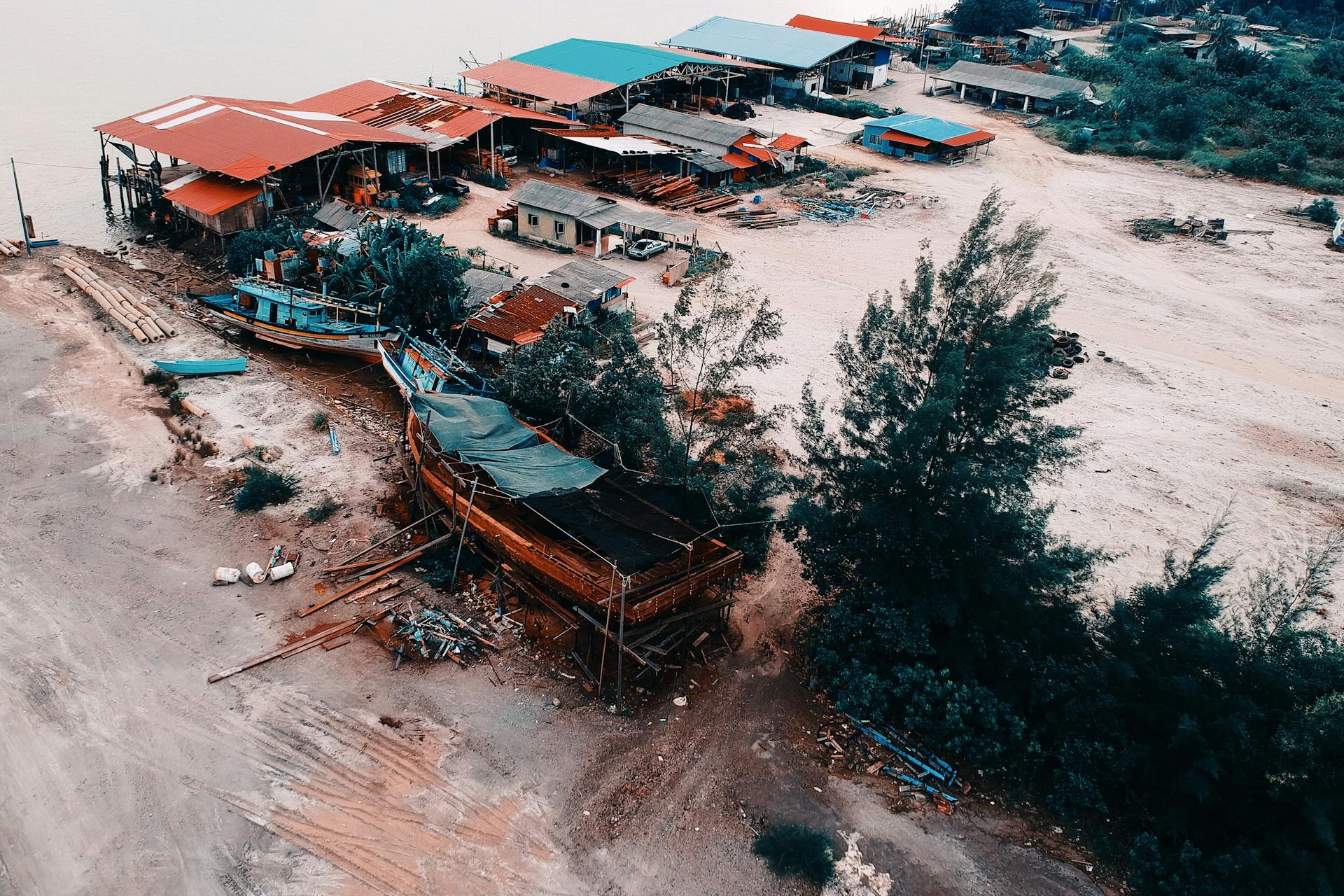
The Burntisland Shipbuilding Company has a rich history dating back to the 18th century. The company's origins can be traced back to 1750 when it was founded by a group of shipbuilders.
The early years of the company were marked by significant growth and expansion, with the shipbuilding industry being a major contributor to the local economy. Burntisland was a hub for shipbuilding, with the company producing a wide range of vessels, from small boats to large merchant ships.
The company's success was largely due to its skilled workforce and innovative designs, which helped to establish Burntisland as a leading shipbuilding center in Scotland.
Early Years
Burntisland Shipbuilding Co. was founded by brothers Amos Ayre and Wilfrid Ayre in 1918 as a First World War emergency shipyard.
The yard was initially located at Burntisland West Dock, which had four berths and the capacity to build ships up to 450 feet long and 59 feet beam.
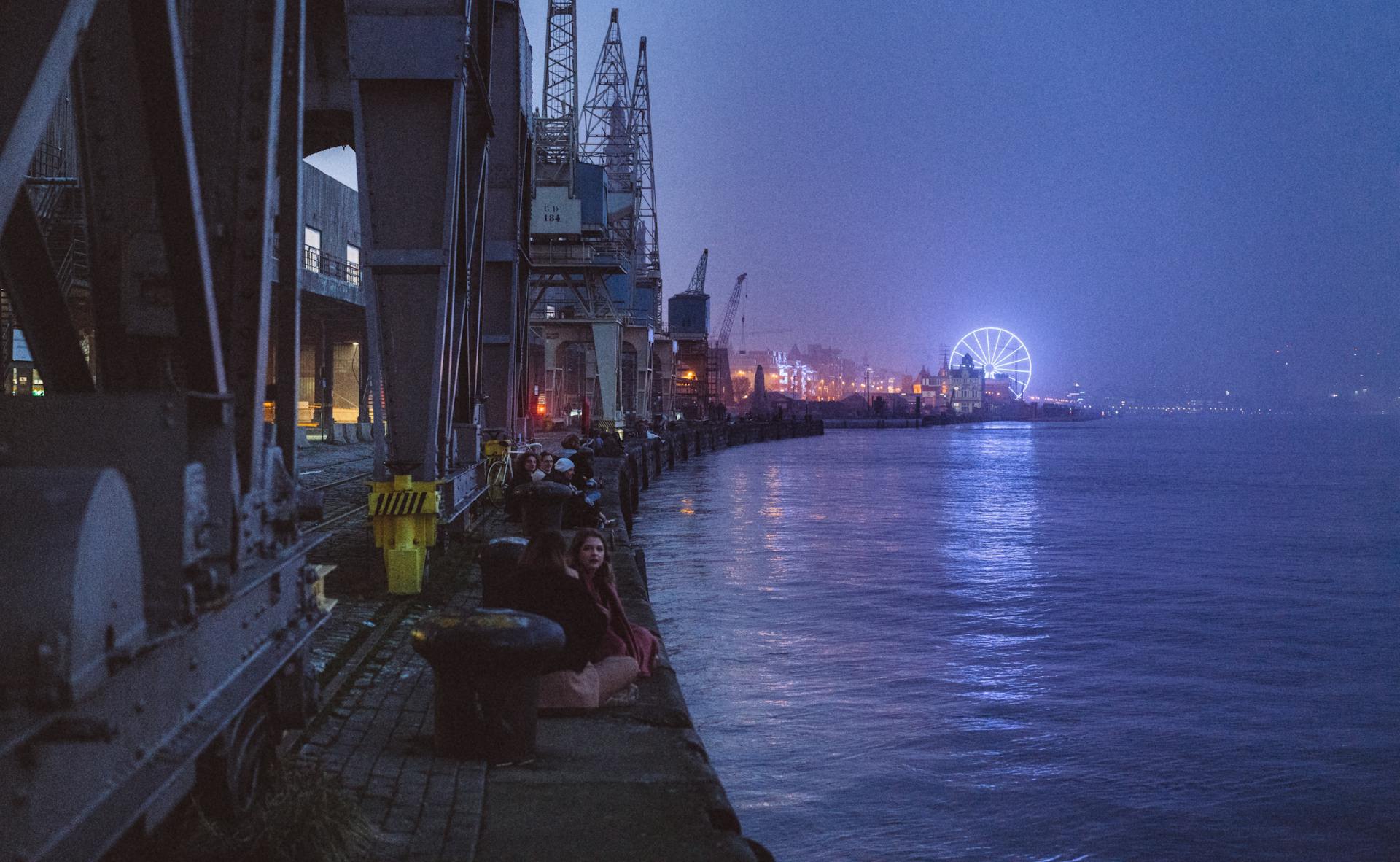
The yard was connected to the North British Railway by an extensive internal rail network that carried steel to various parts of the yard.
Burntisland's first three vessels were standard "C" type cargo ships of just over 3,100 GRT each for the UK Government's wartime Shipping Controller.
They were launched in 1919 after the Armistice as hull numbers 101, 102, and 103, with hull 101 being launched in June as War Brosna, 102 in September as War Dodder, and 103 in November as War Tolka.
The yard's first peacetime order was for a pair of 2,300 GRT cargo steamers for Compagnie Lasry of Oran, Algeria, which were launched in 1920 as Nelly Lasry and Sidney Lasry.
Burntisland built merchant ships ranging from coasters of about 600 tons to ocean-going cargo ships of up to 4,700 tons GRT in the 1920s.
Most common were ocean-going four- or five-hold tramp steamers of 1,500 to 2,500 tons.
Burntisland also built a number of arch-deck colliers from 900 to 2,300 tons GRT.
The yard's first flatiron collier was hull 119, launched in 1922 as the 932 GRT coastal collier Wandle for the Wandsworth, Wimbledon and Epsom District Gas Company.
Burntisland built a further 11 colliers for the same customer between 1923 and 1946.
Hull 174 was launched in 1933 as London Queen, a 781 GRT coaster for the London and Channel Islands Shipping Company.
Burntisland went on to build eight ships for Stephenson, Clarke spread over nearly 30 years, the last being hull 398 launched in 1961 as MV Gilsland.
The Scottish and Mercantile Investment Co bought a majority shareholding in the company in the 1950s, but the Ayre brothers continued to manage the business.
Explore further: London Removals Company
Challenges and Wars
Burntisland Shipbuilding Company faced several challenges during its operation. The company struggled with labor disputes, which led to a significant strike in 1905.
The shipyard's workforce was predominantly made up of skilled laborers, who demanded better working conditions and wages. This led to tensions between management and workers.
The company's location in Burntisland made it vulnerable to economic fluctuations, particularly during World War I. The shipyard's production was impacted by a decline in ship orders.
Surviving the Great Depression

Burntisland Shipyard was well-placed to compete during the Great Depression due to its modern equipment and facilities.
In 1929, the company introduced its "Burntisland Economy" ship design, which was designed for maximum fuel efficiency and became popular with ship-owners during the depression.
The concept was so successful that Burntisland continued to develop it throughout the 1930s, producing a series of efficient ships.
Some of these ships went on to become Empire ships under the Ministry of War Transport in the Second World War, including Hull 164, which was launched in 1935 as Roxburgh and later renamed Empire Tower in 1942.
Burntisland also continued to build numerous colliers during this period, with Hulls 171 and 172 launched in 1932 as Alexander Kennedy and Ferranti for the London Power Company.
The company built six further colliers for the LPC between 1933 and 1945, demonstrating its ability to adapt and thrive during a challenging time.
Burntisland's first diesel ship, Hull 184, was launched in 1934 as MV Charles M, featuring a Humboldt-Deutz engine.
A second Humboldt-Deutz-engined motor coaster, Hull 196, was launched in 1936 as MV Daniel M for T.J. Metcalf of London.
Second World War
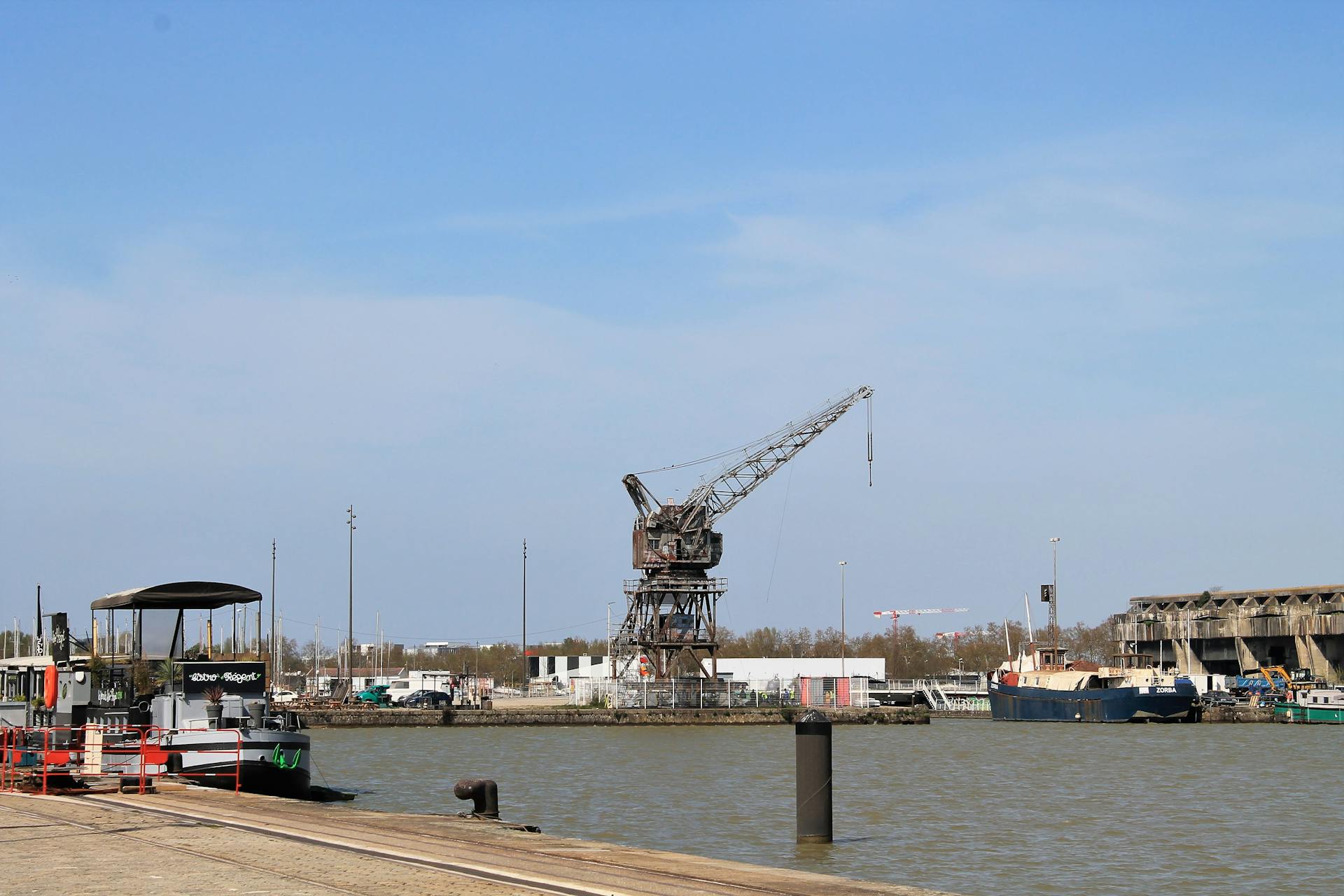
During the Second World War, Burntisland continued to build merchant ships, including three Loch-class frigates: HMS Loch Fyne, HMS Loch Killin, and HMS Loch Glendhu.
The war effort led to an unprecedented rate of shipbuilding, with Burntisland launching several large standard-design cargo ships for the Carlton Steam Ship Co of Newcastle upon Tyne. One of these ships, the Merton, was launched in May 1941 and was the first of its kind.
In 1941, Burntisland also started building colliers for the Gas Light and Coke Company to supply Beckton Gas Works in east London. The first of these colliers, the Adams Beck, was launched in April 1941 and had a capacity of 2,816 GRT.
The war demand rose so high that Burntisland subcontracted orders for five coasters to Hall, Russell & Company of Aberdeen in 1944-45.
Take a look at this: List of Ships Built by William Denny and Brothers
Post-War Era
During the 1960s, Burntisland Shipbuilding Company continued to thrive, securing orders from notable customers and delivering high-quality vessels.
The company built five new coastal tankers for Metcalf Motor Coasters, with the first one, MV Ann M, launched in 1961.
These tankers were followed by several other notable vessels, including MV Montreal City and MV Halifax City, which were sister ships of just over 6,500 GRT for Bristol City Line.
In 1964, Burntisland launched two more sister ships, MV Newfoundland and MV Nova Scotia, for Furness Withy.
These ships were part of a larger order from Furness Withy, highlighting the company's ability to secure significant contracts.
Burntisland also built two coastal tankers for the Nile Steam Ship Co, MV Teviot and MV Traquair, which were launched in 1965 and 1966 respectively.
The company's success during this period was not without its challenges, as the yard's closure was called into question by Labour MP Willie Hamilton in the Commons in 1966.
Production and Decline
The Burntisland Shipbuilding Company was a significant player in the shipbuilding industry, with a production capacity that rivaled other major shipyards of its time.
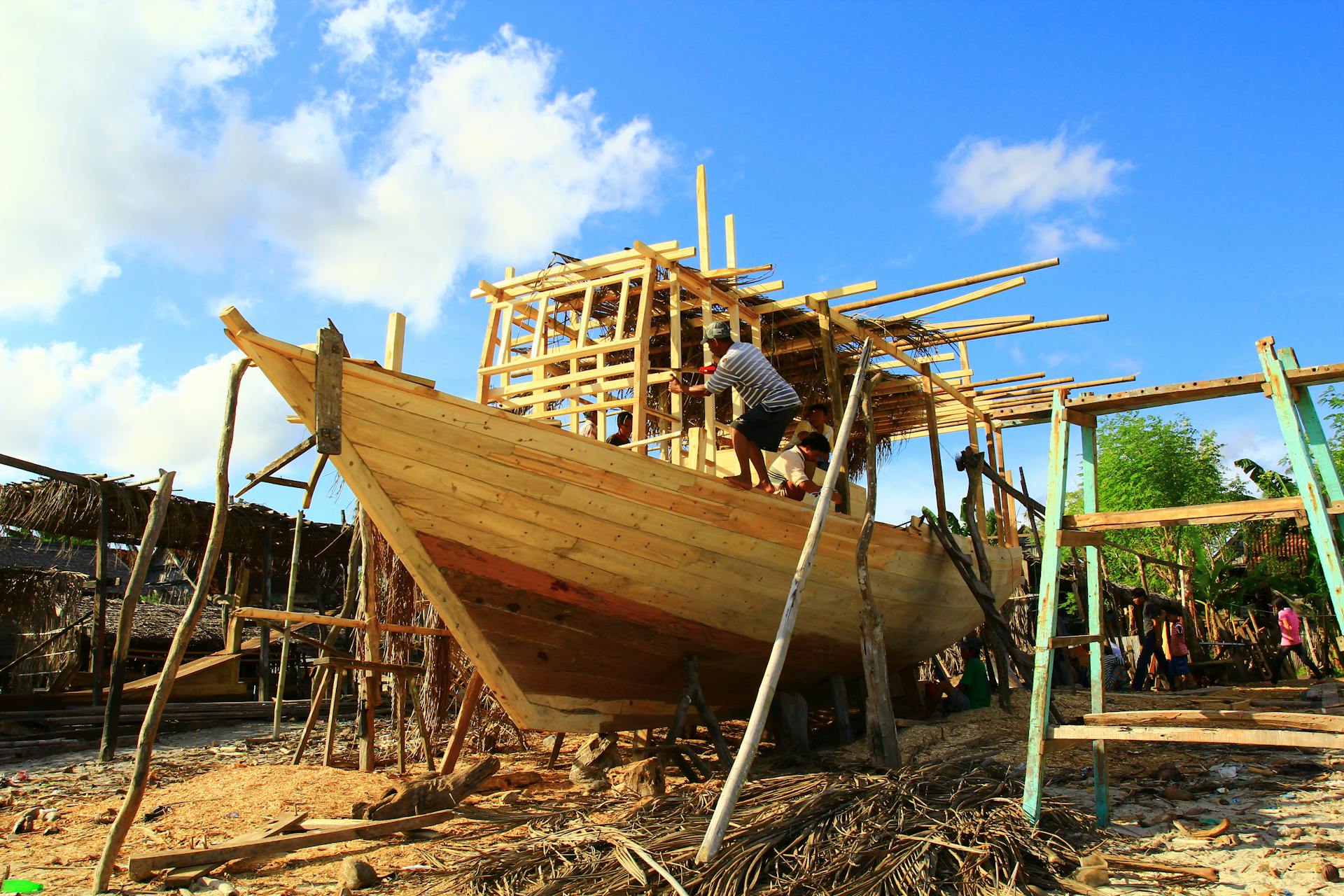
The company's production levels peaked in the late 19th century, with over 300 ships built between 1880 and 1900.
During this period, the shipyard employed hundreds of skilled workers, including shipwrights, engineers, and laborers, who worked tirelessly to meet the demands of the growing shipping industry.
The company's decline began in the early 20th century, as the industry faced increased competition from other shipyards and the effects of World War I took a toll on the economy.
Curious to learn more? Check out: Dalian Shipbuilding Industry Company
1960s Production
In the 1960s, Burntisland was back in business, ordering five new coastal tankers from Metcalf Motor Coasters.
These tankers were launched between 1961 and 1966, with hull numbers 399 to 417. The first, MV Ann M, was launched in 1961.
Burntisland also secured orders from notable customers, including Bristol City Line, Canadian Pacific Steamships, and Furness Withy.
Hulls 402 and 406, launched as MV Montreal City and MV Halifax City, were sister ships for Bristol City Line, while hull 403 became the 4,514 GRT cargo ship MV Beaverpine for Canadian Pacific Steamships.
A fresh viewpoint: MV Hebridean Princess

The yard built two 6,660 GRT sister ships, MV Newfoundland and MV Nova Scotia, for Furness Withy in 1964.
Hulls 414 and 415 were also coastal tankers, built as specialist liquid gas carriers for Nile Steam Ship Co.
The yard launched a larger tanker, hull 416, as the 3,971 GRT MV Olau Mark for Olau Line of Denmark in 1965.
The Burntisland yard's future was uncertain, with Willie Hamilton calling for a public inquiry into its closure in 1969.
However, the government was more concerned with finding a commercial solution to keep the yard in production.
Cancellations and Redundancies
Burntisland Shipbuilding faced significant challenges in the 1950s, with a number of cancelled orders that had a major impact on the workforce.
In 1954, Hull 365 was cancelled, and the following year, Hull 368 was cancelled, but the worst was yet to come.
Six hulls were cancelled in 1959-60, with the first three being for Power S.S. Co. around 1959. By July 2, 1959, the company had laid off 100 workers.
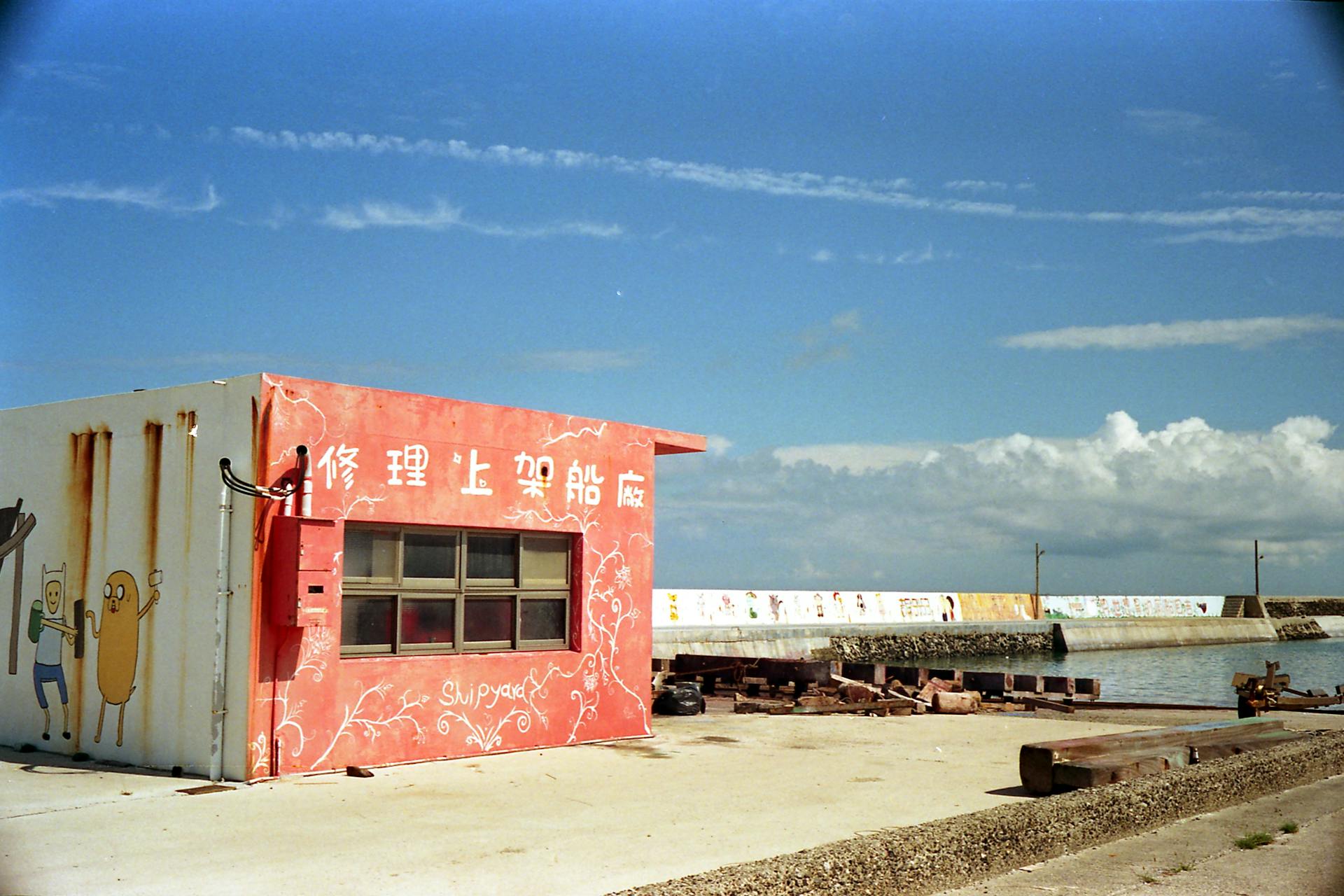
The cancellation of orders led to a significant reduction in the workforce, with about 1,700 people employed in shipyards in Kirkcaldy and Burntisland in 1957, but only around 800 by the end of the decade.
Redundancies continued into the early 1960s, with Harry Gourlay expressing concern in the House of Commons on July 26, 1962, that Burntisland Shipbuilding had made a number of its employees redundant.
The company's workforce continued to decline, with a reduction from around 1,500 in 1961 to just over 500 in 1963, as reported by Gourlay in the Commons on March 14, 1963.
Despite efforts to retrain redundant workers, the number of shipyard workers unemployed in Burntisland rose from six in May 1961 to 116 in May 1963, as conceded by William Whitelaw on May 27, 1963.
Offshore Oil and Gas Fabrications
By 1972, Robb-Caledon had secured orders to build structures for Scotland's North Sea oil and natural gas industry.
The yard was building a structure for Shell's Auk oilfield by December 1972, and in 1973, they received an order for modules for North Sea oil platforms.
In November 1974, Robb-Caledon formed a Burntisland Engineering Fabricators (BEF) subsidiary, and the yard started building modules for the Norwegian sector of the North Sea.
However, the yard lost a potential order for an oil rig to an overseas competitor due to cost and geographical site conditions.
By 1975, BEF had become the UK's leading builder of modules to fit on offshore platforms, despite not securing orders for offshore platforms themselves.
The UK government supported BEF through various loans and grants, including a £450,000 loan under the Industry Act 1972, and almost £1.1 million in grants.
You might enjoy: Offshore Tug Companies
Final Years
The Burntisland Shipbuilding Company's final years were marked by significant changes. The company became a wholly owned subsidiary of British Shipbuilders in 1977.
The Labour Government's decision to nationalise the UK's shipbuilding industry had a profound impact on the company. British Shipbuilders held a 52% share in BEF.
Check this out: Dundee Shipbuilders Company
By 1979, Burntisland was nearing completion of its current order, with no further orders in prospect for the yard. The company was facing an uncertain future.
Les Huckfield MP responded to a question about the yard's future by stating that British Shipbuilders was using its best endeavours to sell the yard as a going concern, thereby preserving employment. This was a glimmer of hope for the workers.
However, on 24 October 1979, Gourlay announced the closure of the Burntisland yard in the Commons. This news would have a devastating impact on the local community.
The Secretary of State for Scotland, George Younger MP, was asked what he would do to help the unemployed find re-employment. It's clear that the closure of the yard had significant consequences for the area.
Related reading: Arab Shipbuilding and Repair Yard Company
Company History
The Burntisland Shipbuilding Co Ltd was founded in 1918 by Amos and Wilfrid Ayre.
In its lifetime of just over 50 years, the company built 310 ships. This impressive number is a testament to the hard work and dedication of the shipyard's employees.
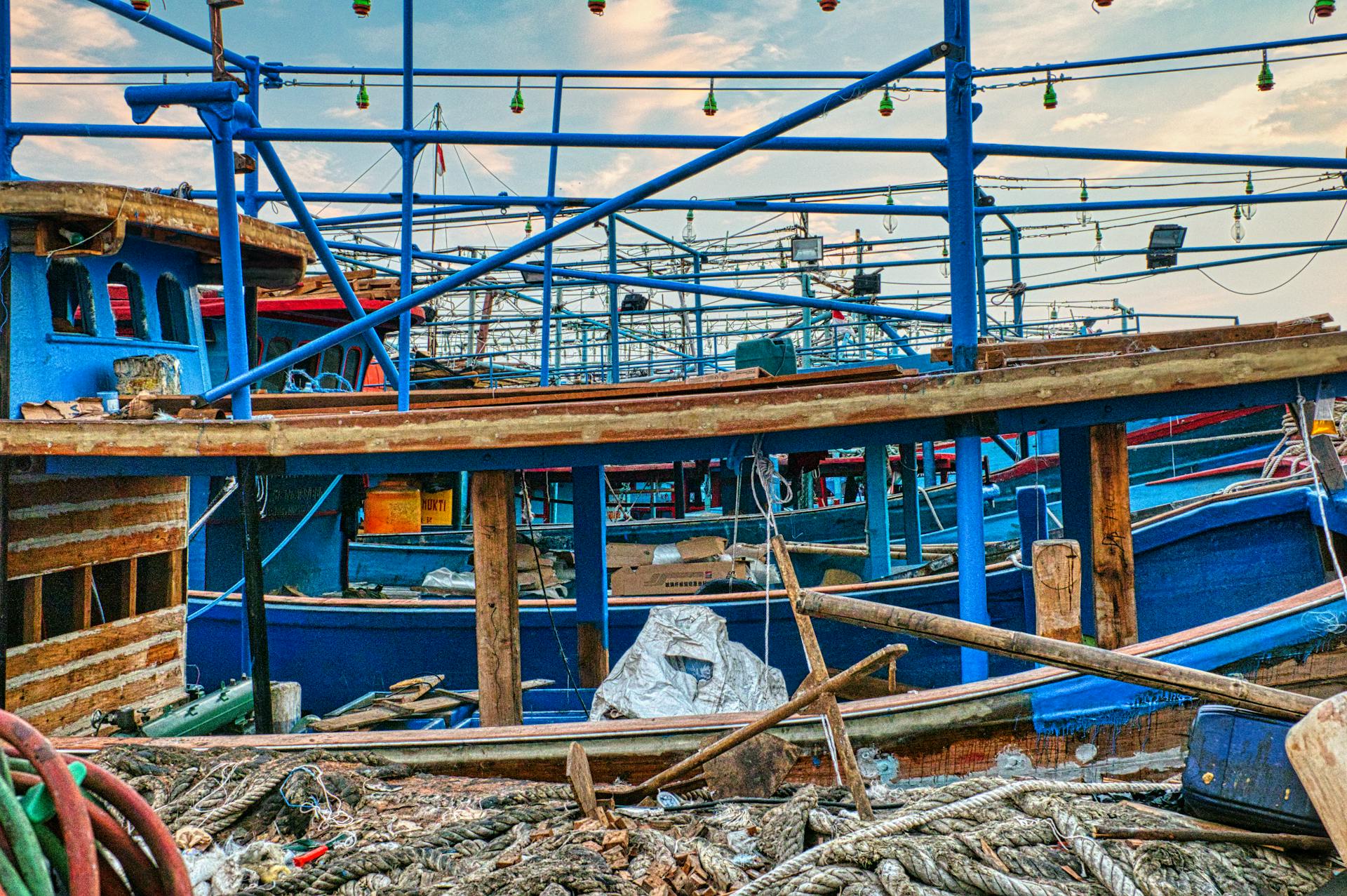
The shipyard had a long and chequered history, but it's worth noting that the 1960s were difficult times for Scotland's long-established shipyards.
Burntisland Shipyard closed in 1969, after a series of problems led to its liquidation. This was a significant blow to the local community.
The problems began with the construction of the 'Ohrmazd', a fast cargo liner for the East & West Steamship Company of Karachi, Pakistan. This ship was effectively being paid for by the British Government, as part of its foreign aid to Pakistan.
The construction of the 'Ohrmazd' was plagued by wrangles over specifications and contract terms between the shipyard and the shipowners.
Curious to learn more? Check out: Lockheed Shipbuilding and Construction Company
Notable Ships
Burntisland Shipbuilding Company had a notable output of ships during its operations. The yard launched four more ships after launching Ohrmazd, including the MV Peter Schröder and MV Paul Schröder, two cargo ships for Reederei Richard Schröder of Hamburg, Germany.
The MV Peter Schröder and MV Paul Schröder were cargo ships of just over 5,000 GRT, launched in 1967 and 1968 respectively. Hull 421, launched as MV Christiane Bolten, was a similar cargo ship for August Bolten William Miller's Nachfolger of Hamburg.
The yard's final vessel, Hull 422, was launched as MV Helen Miller for the St. Vincent Shipping Co. of Liverpool in April 1969.
For your interest: James N Miller & Sons
Turbine Steamers
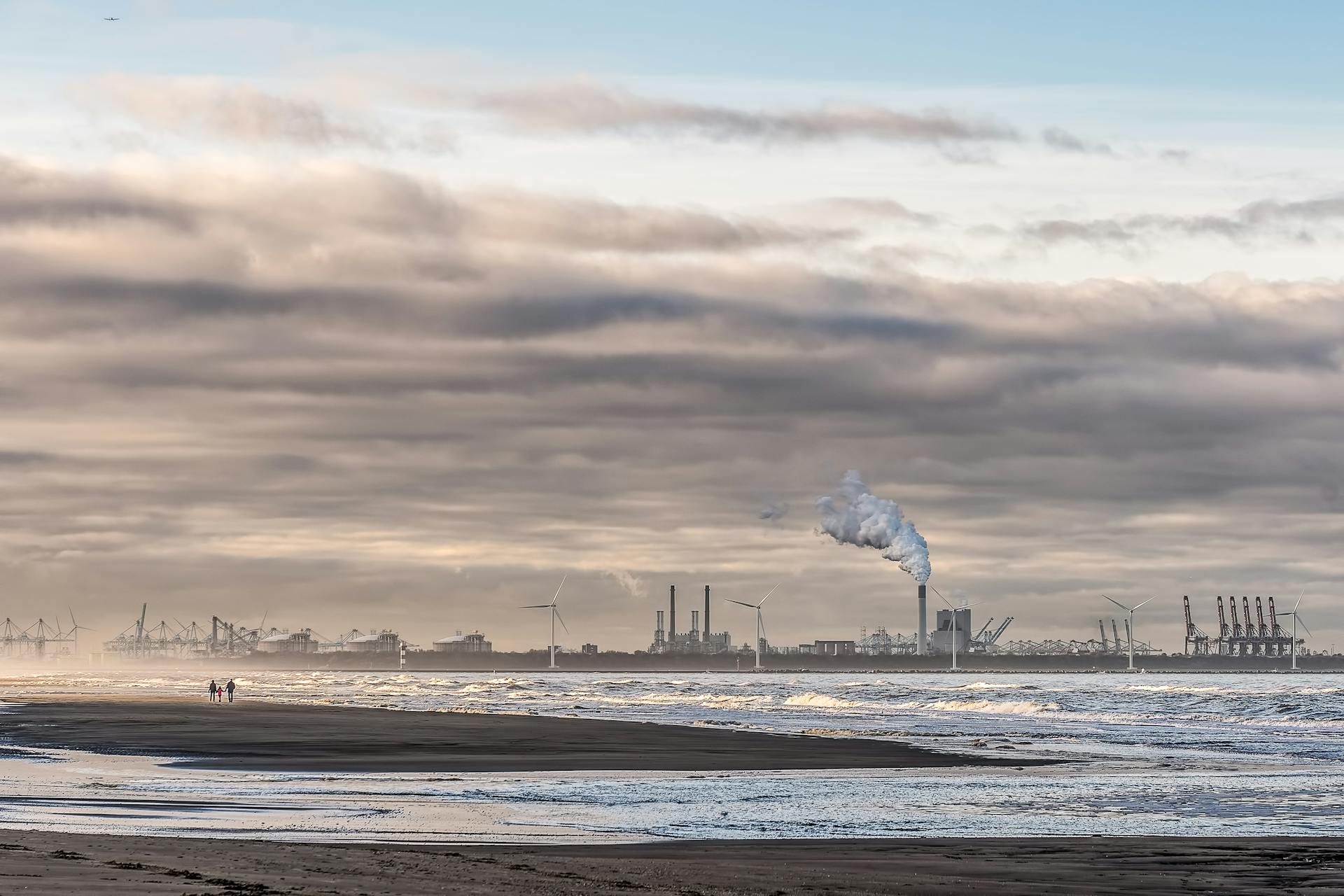
Turbine steamers were a popular choice in the 1950s due to their compact design and reduced vibration compared to reciprocating engines.
Early in the decade, Burntisland took two notable orders for steam turbine cargo ships. The first two ships were the ore carriers TSS Dispatcher and TSS Discoverer, launched in 1953 and 1954 respectively.
The TSS Dispatcher was a 5,000 GRT vessel, while her sister ship, the TSS Discoverer, was slightly smaller at 4,952 GRT.
The turbines and reduction gearing for both ships were built by David Rowan and Company of Glasgow, part of Lithgows Limited.
A second turbine order was placed for the TSS Sunvictor, launched in 1956 for Skibs A/S Geirulv of Norway.
MV Empire MacAlpine
The MV Empire MacAlpine was a grain ship converted to become the first Merchant Aircraft Carrier (MAC ship). She was built by the Burntisland Shipbuilding Company in Fife, Scotland, under order from the Ministry of War Transport.
The Empire MacAlpine was delivered on 14 April 1943, and her air crew and maintenance staff were the only naval personnel on board. She was operated by William Thomson & Co (the Ben Line).
She was a significant vessel, with a displacement of 7,950 tons and a length of 412 ft 6 in (p.p.) and 433 ft 9 in (o/a). The Empire MacAlpine was powered by a 3,300 hp diesel engine and had a speed of 12.5 kn (23.2 km/h).
She was equipped with a 4 in (100 mm) dual purpose gun, 2 × 40 mm anti-aircraft guns, and 4 × 20 mm anti-aircraft cannons. The Empire MacAlpine also carried 4 aircraft.
Here's a list of her notable names:
- Empire MacAlpine (1942-1951)
- Derrynan (1951-1959)
- Huntsbrook (1959-1960)
- Suva Breeze (1960-1965)
- Djatingaleh (1965-1966)
- San Ernesto (1966-1968)
- Pacific Endeavour (1968-1970)
Sources
- https://en.wikipedia.org/wiki/Burntisland_Shipbuilding_Company
- https://www.gracesguide.co.uk/Burntisland_Shipbuilding_Co
- https://www.burntislandheritage.org.uk/Index.asp
- https://archivestest.grlc.vic.gov.au/drawing-no-1712-18-s-s-matthew-flinders-general-arrangement-built-burntisland-shipbuilding-co-ltd-1939-scale-n-a
- https://military-history.fandom.com/wiki/MV_Empire_MacAlpine
Featured Images: pexels.com


